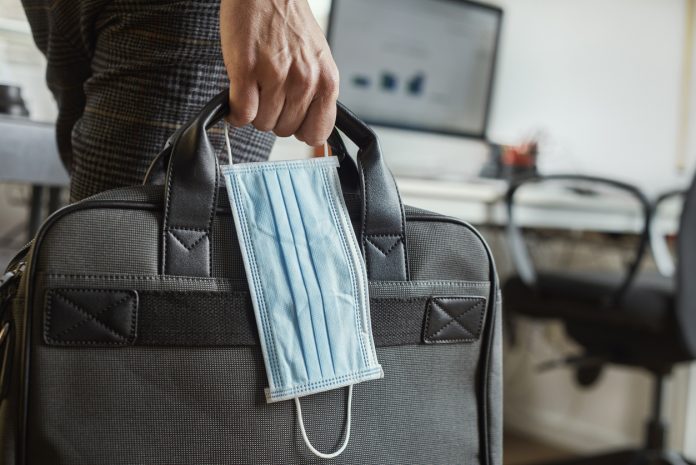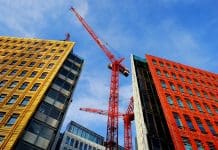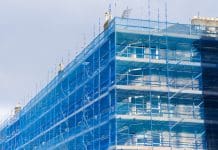With the rollout of the Covid-19 vaccine programme, businesses might be tempted to relax measures to control the spread of the virus. But, until a majority of the population has been vaccinated, it is critical workplaces maintain good levels of ventilation to help mitigate against airborne transmission of coronavirus, says Hywel Davies, technical director of the Chartered Institution of Building Services Engineers (CIBSE)
With the first phase of the Covid-19 vaccination programme gaining pace, the ambition is for everyone in the UK in the most vulnerable groups, as many as 31m people, to be vaccinated as quickly as possible. Once the over-50s, younger people with health conditions and NHS and care workers have been vaccinated, Boris Johnson has been clear that the current restrictions will begin to be lifted, in stages, with schools and education the top priority. Getting business back to work will also be high on the list.
But even if the vaccine rollout does go to plan, businesses will still need to operate strict Covid-19 measures to protect their staff and visitors to their premises. The full scale of the effectiveness of the vaccine is still to emerge; it is unclear how effectively it will reduce transmission or how long vaccine-induced protection will last. If we are looking to start lifting restrictions and reopening businesses as early as Easter, many will not be vaccinated at that point.
As the Joint Committee on Vaccination & Immunisation has yet to decide on vaccination priorities in the rest of the population, a large proportion of the working-age population will not have been immunised by the time the current restrictions are eased. For businesses, that means the focus in workplaces and other multi-occupant spaces, especially those open to the public, must remain on limiting transmission to prevent the spread of coronavirus to unvaccinated people.
The role of ventilation
The Government’s Scientific Advisory Group for Emergencies (SAGE) has published detailed guidance in the Role of Ventilation in Controlling SARS-CoV-2 Transmission. This document makes clear that: “Ventilation should be integral to the Covid-19 risk mitigation strategy for all multi-occupant public buildings and workplaces.”
The SAGE publication follows acknowledgement last July by the World Health Organisation of the possibility of airborne transmission. This, in turn, confirmed the lead provided by the CIBSE in its Covid-19 Ventilation Guidance document, issued in May last year and referenced by the SAGE guidance.
Covid-19 is transmitted in three ways. Larger droplets generated by infected people fall under gravity within 2m of the host, which is why social distancing of 2m matters.
The droplets fall on to surfaces and can therefore get on to hands, eating utensils, food and even shoes – hence the importance of frequent handwashing and avoiding touching the face, as well as minimising common touchpoints.
The need for effective ventilation follows clear evidence that coronavirus is spread by tiny particles called aerosols.
An infected person who talks, coughs or sneezes produces droplets and aerosols containing pathogens. The aerosols can stay airborne for and travel further, particularly in poorly ventilated spaces, and may infect others. There is an even greater concern with the more transmissible new variants.
The principle promoted by CIBSE and SAGE is to dilute the infectious material and remove airborne pathogens from a space quickly to reduce opportunities for surface deposition or inhalation by others. The risk increases as the concentration of pathogens in the air increases.
SAGE says modelling shows that “exposure to aerosols approximately halves when the ventilation rate is doubled”. For offices and business premises, this means taking steps to increase both the supply of outside air and the rate of exhaust ventilation as much as is reasonably possible while minimising, or eliminating, the recirculation of air.
In addition, for spaces with mechanical ventilation CIBSE recommend starting the ventilation system at least an hour before occupancy and continuing to run the system for at least an hour after everyone has left to help purge the space of aerosols.
Similarly, for ventilation systems where the rate of fresh air supply is controlled to maintain a minimum CO2 level, CIBSE recommends changing the CO2 set point to a lower value to maximise the flow of outside air.
Another important CIBSE recommendation is to stop the recirculation of air between spaces and rooms occupied by different groups of people, unless recirculation is the only way of maintaining adequate levels of outside air to these spaces. Systems with thermal wheels should be inspected by a competent person to assess any risk of air leakage from the exhaust flow into the supply air and to adjust the system to eliminate any transfer which could carry viral material into the supply airstream.
Providing effective ventilation
In a building or workplace with a ventilation system that is properly designed, constructed and maintained to current standards, SAGE says the risk of aerosol transmission is likely to be low. In most workplaces this equates to a space having an outside air supply rate of 8-10 litres per second, per person; which is the minimum outside air supply rate for most offices recommended by CIBSE and which also satisfies the building and workplace regulations.
Providing effective ventilation is more of a challenge in older buildings, as systems may not have been designed in line with current ventilation standards or have been extended and altered over time. To help building owners and operators understand the types of ventilation systems commonly encountered in buildings and how these can be used to best reduce the risks of airborne infection CIBSE has produced a Covid-19 Ventilation Guidance document.
The guidance will help building managers and those who operate and maintain building systems to identify those areas of a building and elements of ventilation systems that may need particular attention to reduce the risks to the building occupants. CIBSE’s general advice is that ventilation rates should be increased as much as reasonably possible without compromising thermal comfort.
In poorly ventilated spaces with high occupancy where it is difficult to increase ventilation rates or reduce occupancy, it may be appropriate to consider installing air cleaning or ultraviolet light disinfection devices.
Room air cleaners are standalone devices containing a fan to pull air through a high efficiency air filter, which can help remove aerosols. Ultraviolet systems can take various forms but most use light with a wavelength of 254nm to render viruses ineffective by destroying genetic information in their DNA. Any such installation should use equipment with robust test data to show its effectiveness and needs to be of an appropriate size to handle the volumes of air requiring treatment. The installation needs to be designed to meet the particular requirements of the space and the activities being undertaken.
For buildings reliant on opening windows and doors for ventilation, CIBSE advice is that windows and vents should be used more than normal. Opening windows can result in draughts and occupant discomfort, so one alternative is to encourage all occupants to take regular breaks simultaneously throughout the day to allow the space to be purged with outside air. Managers should also review dress codes to allow staff the freedom to wear warmer clothes if they wish.
Embedding disease transmission in Building Regulations
Unfortunately, the reality is that unlike distancing and hand washing, ventilation requirements cannot easily be distilled into one simple approach that everyone can follow. Adapting the ventilation in many environments is challenging and will require the type of engineering expertise CIBSE members can provide in order to ensure mitigation measures will be effective for a particular space, ventilation system, user group and activity.
In the longer term, CIBSE expects consideration of infectious disease transmission to be embedded into Building Regulations, specifically those dealing with the provision of ventilation, in the same way that energy, comfort and air quality are already included. In England and Wales, Approved Document F: Ventilation is currently under review and CIBSE is contributing to the review process.
CIBSE Covid-19 Ventilation Guidance is available as a free download from the CIBSE website: www.cibse.org/coronavirus-covid-19/emerging-from-lockdown
 Hywel Davies
Hywel Davies
Technical director
Chartered Institution of Building Services Engineers
Tel: +44 (0)20 8675 5211
www.cibse.org/coronavirus-covid-19
Twitter: CIBSE
LinkedIn: cibse
YouTube: cibse
YouTube: cibse














